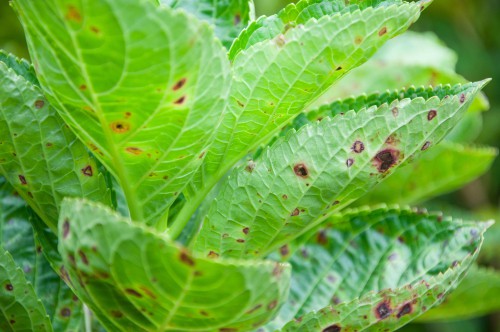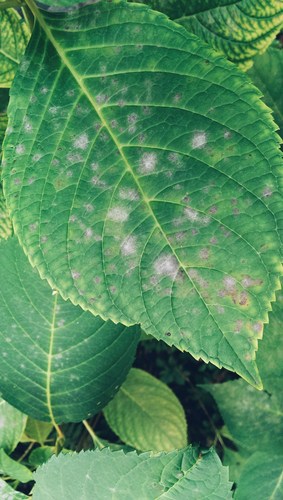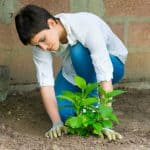Last updated on March 6th, 2022
Our site is reader supported, this means we may earn a small commission from Amazon and other affiliates when you buy through links on our site.
Hydrangeas are fairly easy to take care of in terms of their maintenance. Regardless of the variety you choose, they will bring a great deal of beauty and joy to your garden with impressive displays of flowers and foliage. However, there are a few common pests, diseases (and other problems) that might impact your Hydrangea that you need to be aware of.
Common Diseases
Leaf Spot
The most common disease you will see with your Hydrangea is leaf spot and this is usually the result of a fungal infection. Fungal diseases like these manifest in locations where the ground remains too moist and the roots get too damp, or there is insufficient airflow throughout the plant.

This is more likely to take place during warm moist seasons. You can prevent this by being particularly aware of how frequently you water. Yes, Hydrangeas need moist soil but this does not mean you have to water them regularly. Consider that if you have added mulch to the top of your soil to help keep the roots cool this will naturally retain moisture and means you won’t need to water as much. Similarly, you should avoid watering overhead on the leaves and instead, water directly at the base of the plant.
Powdery Mildew

Tangentially powdery mildew is a common problem that won’t harm your Hydrangea but will have an impact on the appearance. If you notice powdery white mildew on top of the leaves and your flowers are also not blooming, you might need to cut away some of the branches in order to promote better air circulation and alleviate the conditions.
Rose Chafers (Beetles)
Rose Chafers are beetles that are known for eating the flowers of Hydrangea and the telltale sign is that you will notice small holes in the petals. They also eat the leaves between the veins leaving a skeleton-like structure. The best non-chemical way to help prevent this is to check the leaves and remove any affected leaves from the plant. Pesticides can also be successful and have more immediate results.
Bacterial Leaf Spot
Bacterial leaf spot can be problematic and this doesn’t manifest in the form of mould spots so to speak, but rather in the form of discolouration on the leaves themselves. You might notice black lesions on your Hydrangea or brown spots that have a yellow perimeter. Regular, small brown spots like these will cause your leaves to dry up and eventually break.
If the area in which your Hydrangea is planted is exposed to severe wet and cool conditions this might promote the growth of bacteria. It could also be something as simple as removing bacteria-laden leaves from another part of your garden and in doing so some of the bacteria splashed off those leaves and onto your Hydrangea. In any case, if you notice this use a bactericide immediately to treat it and prevent it from getting worse.
Common Pests
There are some common pests that adversely impact your Hydrangeas. Spider mites are common pests, however, they aren’t a pest that you necessarily need to remove simply because they serve a purpose, feeding on the other insects that are cause for concern.
Spider Mite
Spider mites are very small and they will eat away at your Hydrangea leaves. They start by piercing each of the leaves and removing fluid inside. You can tell when you have an issue with spider mites because this process leaves small yellow spots in its wake. If you notice spider mites you need to remove them by spraying water on them to physically knock them off the leaves.
Aphids
Whiteflies, greenflies and aphids are other common pests that present problems for Hydrangeas. These aphids will penetrate the leaves and remove sap from inside the tissue of the Hydrangea. You can tell if you have problems with whiteflies or aphids because the result of this sap removal turns the leaves yellow, causes them to curl up from the edges inward, and in some cases fall off entirely. The leaves often also feel sticky and lead to honeydew.
To remove these you can mix dish soap and water together but you must thoroughly coat every part of the Hydrangea, literally the top of the leaves, the underside of the leaves and everywhere in between. Do not do this when the morning sun is hitting your Hydrangea or it can scorch the leaves. You can also use a pesticide to spray plants but we always recommend this as a last resort because we should use chemicals as little as possible.
Hydrangea Scale

Hydrangea scale is another more common pest that is difficult to treat because they have a protective waxy coat that protects them from any sprays. They can be identified by the oval white eggs that attach themselves to the stems of the plant. A painfully slow way to try and get rid of these is to remove the eggs manually and this takes a lot of patience. The best way to treat the Hydrangea scale is by spraying with a pesticide but this needs to be done around mid-July to kill the young nymphs before they develop their waxy protective scale.
Slugs and Snails

Everybody knows what slugs and snails are and thankfully they are not too much of a problem with Hydrangeas as they can be with softer plants. However, young foliage is most at risk and it can be a problem sometimes. The best way to treat is to simply put down some slug and snail pellets.
Other Problems
Aside from issues relating to pests or diseases you might notice that your Hydrangea isn’t flowering. It might simply be blooming insufficiently, especially in comparison to previous seasons’ or it’s just not flowering at all.
My Hydrangea isn’t flowering
Realistically in these situations, the culprit is likely unnecessary pruning at the wrong time of the year. It is fairly common for homeowners to mistakenly prune one season at the wrong time because they don’t necessarily know which variety of Hydrangea they have and they end up removing the old wood from the previous season, unaware that that is the wood on which the following season’s flowers bloom. If this is the case, simply continue your regular maintenance routine.
Last update on 2025-08-05 / Affiliate links / Images from Amazon Product Advertising API








2 Comments
I have a beetle type pest on my hydrangeas any idea what it could be or how to treat them please
Possibly vine beetle, not 100% but the adult’s beetles may eat the leaves but if you have them in pots the reel damage is done by the grubs when the eggs hatch as they eat the roots of plants. More of a problem with plants in pots though, try something like Provado Vine Weevil Killer.